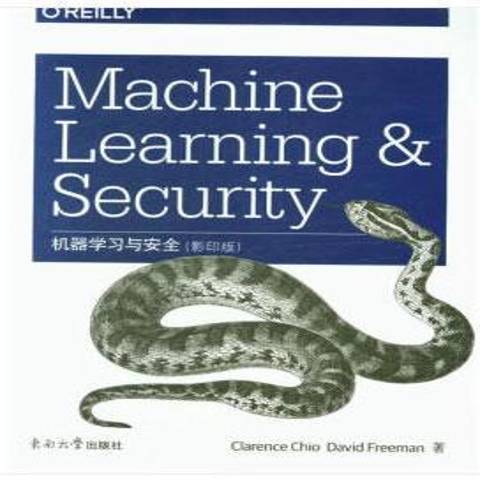《機器學習與》是2018年東南大學出版社出版的圖書。
基本介紹
- 中文名:機器學習與
- 作者:Clarence Chio、David Freeman
- 類別:機器學習
- 出版社:東南大學出版社
- 出版時間:2018年11月
- 開本:16 開
- 裝幀:平裝
- ISBN:9787564179793

《機器學習與》是2018年東南大學出版社出版的圖書。
《機器學習與》是2018年東南大學出版社出版的圖書。內容簡介 機器學習技術能夠解決計算機安全問題,並*終為攻防雙方之間的貓鼠遊戲畫上一個句號嗎?或者說這只是炒作?現在你可以深入這一學科,自己回答這個問題了!有了《機器學習與安全(...
機器學習與安全是一本2019年出版的圖書,由中國電力出版社出版 內容簡介 ■快速檢測異常現象,包括違規操作、欺詐和即將發生的系統故障。■通過從計算機二進制檔案中提取的有用信息進行惡意軟體分析。■通過從數據集中查找模式來發現網路中的...
第1~3章為第一部分,介紹機器學習的基本原理、所需的數學知識(包括微積分、線性代數、機率論和最最佳化方法),以及機器學習中的核心概念。 第4~20章為第二部分,是本書的主體,介紹各種常用的有監督學習算法、無監督學習算法、半監督...
《機器學習與智慧型感知》是2023年9月1日清華大學出版社出版的圖書,作者:張寶昌、黃雷、丁嶸、王 田。內容簡介 本書旨在通過對機器學習主要原理和方法的介紹,並且結合作者多年來在智慧型感知方面的研究成果,對其他書籍未涉及的一些前沿...
《機器學習與深度學習(基於Python實現)》是2023年中國水利水電出版社出版的圖書。內容簡介 本書用 Python 對人工智慧機器學習中的相關知識進行了算法實現,並以這些知識為背景解釋了什麼是深度學習。具體內容包括初識機器學習、機器學習基礎...
主要從事於機器學習與深度學習在圖像處理以及地球物理領域內的相關套用研究,對機器學習相關算法有較深的理解。參與過多項機器學習相關工程項目,發表SCI期刊論文及會議論文數篇。曾獲得國家獎學金、數學建模一等獎、優秀畢業生等獎項和榮譽...
《機器學習與深度學習》是電子工業出版社於2022年出版的書籍,作者是陶玉婷。內容簡介 本書是“高級人工智慧人才培養叢書”中的一本,首先介紹了機器學習的相關概念和發展歷史,並在此基礎上提出了深度學習——它本質上是近幾年來大數據...
《機器學習與人工智慧》是科學出版社出版的圖書,作者是張舉華。 內容簡介 本書涵蓋了與人工智慧相關的機器學習核心方法,包括深度卷積神經網路、循環神經網路、生成對抗網路、蒙特卡羅樹搜尋、強化學習。本書也包括一些套用非常廣泛的機器學習...
《機器學習與算法套用》是2022年電子工業出版社出版的圖書,作者是許桂秋、湯海林、武文斌。內容簡介 本教材從實用的角度出發,採用理論與實踐相結合的方式,介紹機器學習算法與套用的基礎知識,力求培養讀者使用機器學習相關算法進行數據分析的...
《機器學習與人工智慧從理論到實踐》是2021年機械工業出版社出版的圖書。內容簡介 本書理論與實踐相結合,全面介紹人工智慧(AI)和機器學習(ML)。全書分為六部分。部分介紹人工智慧和機器學習在現代背景下的概念以及它們的起源和現狀,...
3. Statistical Learning 統計學習… ………73 3.1 Machine Learning and Inferential Statistical Analysis 機器學習與推斷統計分析 ………73 3.2 Descriptive Statistics in Learning Techniques 學習技術中的描述統計學 ………74 3.2....
《機器學習套用與實戰(全彩)》是電子工業出版社出版的圖書,作者是韓少雲。《機器學習套用與實戰(全彩)》系統介紹了機器學習常用算法及其套用,在深入分析算法原理的基礎上,結合當前熱門套用場景,向讀者展現了機器學習算法的綜合套用,...
《機器學習原理與實戰》是2021年人民郵電出版社出版的圖書,作者是何偉、張良均。內容簡介 本書以Python機器學習常用技術與真實案例相結合的方式,深入淺出地介紹了Python機器學習套用的主要內容。全書共11章,分別介紹了機器學習概述、數據...
第1章機器學習概述 1.1機器學習基本概念 1.1.1人工智慧與機器學習 1.1.2機器學習基本術語 1.1.3機器學習誤差分析 1.2機器學習發展歷程 1.2.1感知機與連線學習 1.2.2符號學習與統計學習 1.2.3連線學習的興起 1.3機器學習...
《機器學習與最佳化》是2020年2月人民郵電出版社出版的圖書,作者是[意]羅伯托·巴蒂蒂(Roberto Battiti) 、毛羅·布魯納托。內容簡介 本書是機器學習實戰領域的一本佳作,從機器學習的基本概念講起,旨在將初學者引入機器學習的大門,並...
《Python機器學習與可視化分析實戰》是2022年清華大學出版社出版的圖書,作者是王曉華。內容簡介 使用機器學習進行數據可視化分析是近年來研究的熱點內容之一。本書使用Python作為機器學習的基本語言和工具,從搭建環境開始,逐步深入到理論、代碼...
《機器學習入門與實戰——Python實踐套用》是2023年清華大學出版社出版的圖書,作者是冷雨泉、高慶、閆丹琪。內容簡介 本書主要介紹經典的機器學習算法的原理和改進,以及Python的實例實現。本書的內容可以分成三部分: 第一部分是機器學習...
《機器學習與大數據技術》是2018年12月人民郵電出版社出版的圖書,作者是牟少敏。內容簡介 本書較為全面地論述了機器學習、深度學習、大數據技術與圖像處理技術的基本概念、基礎原理和基本方法,以農業為套用場景,力求通縮易懂,深入淺出的...
《 機器學習原理與實踐(Python版)》是2021年清華大學出版社出版的一本圖書,作者是左飛,補彬。 內容簡介 本書全面系統地介紹了機器學習領域中的經典方法,併兼顧算法原理與實踐運用。具體內容涉及回歸分析(線性回歸、多項式回歸、...
《機器學習與資產定價》由電子工業出版社2022年出版,原著由芝加哥大學Stefan Nagel教授寫作,中文版由北京大學王熙教授和麻省理工學院石川博士翻譯。內容簡介 本書從資產定價的核心問題出發,前沿而體系化地討論了如何通過經濟學推理將機器學習...
《機器學習與數據挖掘》是2004年電子工業出版社出版的圖書。內容介紹 本書分為5個部分,共18章,較為全面地介紹了機器學習的基本概念,並討論了數據挖掘和知識發現中的有關問題及多策略學習方法,具體地闡述了機器學習與數據挖掘在工程...
1.3機器學習的套用3 1.4機器學習方法的實現4 1.4.1機器學習與Python4 1.4.2NumPy庫5 1.4.3Matplotlib庫6 1.5本章實驗分析8 1.6本章小結9 1.7思考與練習10 第2章監督學習11 2.1線性回歸12 2.1.1線性回歸的數學模型...
該書講述了關於機器學習的綜合性教程,涵蓋全部基礎知識和理論,涉及不同套用領域的技術和算法。書中提出,機器學習背後的大多數想法都是簡單且直接的。內容簡介 為了鼓勵讀者在實踐中理解機器學習算法,本書提供一個配套平台,利用自我學習...
《機器學習入門與實戰(微課版)》是2023年電子工業出版社出版的圖書,作者是王志、陶再平。內容簡介 本書以掌握Python語言基礎為前提,由淺入深、全面系統地講解了機器學習的相關知識及技能,內容注重實用性和可操作性,在介紹機器學習...
機器學習是當前解決很多人工智慧問題的核心技術,自2012年以來,深度學習的出現帶來了人工智慧復興。本書是機器學習和深度學習領域的入門與提高教材,緊密結合工程實踐與套用,系統、深入地講述機器學習與深度學習的主流方法與理論。全書由23章...
《Python機器學習及實踐》是清華大學出版社2020年出版的圖書,作者是梁佩瑩。內容簡介 Python是目前比較熱門的程式語言,以簡單易學、套用廣泛、類庫強大而著稱,是實現機器學習算法的首選語言。本書以Python 3.6.5為編寫平台,以幫助讀者...
《 機器學習基礎與實踐》是2021年清華大學出版社出版的圖書,作者:楊金坤 、馬星原、張力寧、張峻。內容簡介 本課程從實踐角度考慮,結合部分數學統計學知識講解最經典的機器學習算法,主要內容是機器學習思想在具體項目上的示例和代碼...
